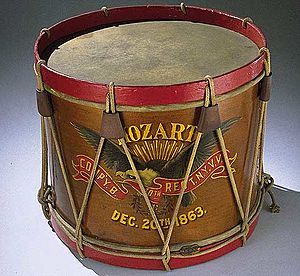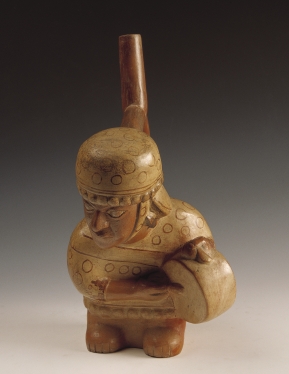Drum facts for kids
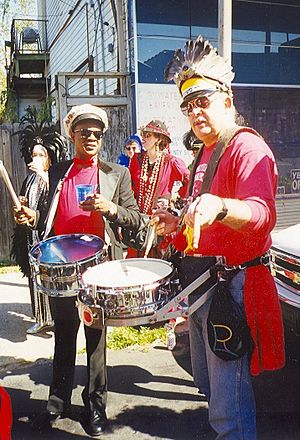
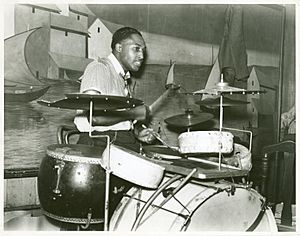
A drum is a musical instrument that you hit with your hands or with a drum stick. Drums are part of the percussion instrument family. This means they make sound when they are hit. Other percussion instruments include cymbals and cowbells.
Drums are super important in music because they help keep a steady beat. They also give music a certain feeling. For example, if you want a song to be slow and calm, the drums will play slowly. If you want it to be fast and exciting, the drums will play faster!
A group of drums and cymbals is called a drum kit or drum set. Drum kits are used in almost all types of popular music. You'll hear them in rock, jazz, country, blues, and many other styles.
Contents
How are Drums Used?
Drums are usually played by hitting them with your hands or with sticks. There are many different kinds of sticks. Some are made of wood, and some have soft felt ends.
Drums are used in many ways around the world.
- In many traditional cultures, drums are very special. They are used in religious ceremonies and have a symbolic meaning.
- Drums are also used in music therapy. This is because they are easy to play and feel good to hit. Hand drums are especially popular for this.
- In popular music and jazz, when people say "drums," they usually mean a drum kit. The person who plays them is called a "drummer."
How are Drums Made?
A drum has a main body called a shell. This shell usually has a round opening. A special skin or material, called a drumhead, is stretched over this opening.
Different Drum Shapes
Drum shells come in many shapes.
- Most drums in Western music are shaped like a cylinder.
- Timpani drums have a bowl shape.
- Other drums can be shaped like a frame (like the Bodhrán), a goblet (like the djembe), or even joined cones (like the talking drum).
Drumheads and Tuning
Drums can have one drumhead or two.
- Single-headed drums usually have one skin stretched over an enclosed space.
- Drums with two heads often have a small hole in the middle of the shell. This hole helps the sound echo inside.
- Some drums with two heads have special wires called snares. These wires are stretched across the bottom drumhead (or sometimes both). This is what gives the snare drum its unique buzzing sound.
On modern drums, the drumhead is held onto the shell by a "counterhoop" or "rim." This rim is tightened with screws called "tension rods." By tightening or loosening these rods, you can change how tight the drumhead is. This changes the sound of the drum. Most drums have six to ten tension rods.
Before tension rods were invented, drum skins were tightened using ropes or pegs. The Djembe drum still uses ropes to tune its sound.
How Drums Make Sound
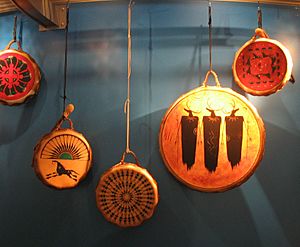
Many things affect the sound a drum makes. These include:
- The type and shape of the drum shell.
- The material and thickness of the drumheads.
- How tight the drumheads are.
Different drum sounds are used for different types of music. For example, a jazz drummer might want drums that sound high-pitched and clear. A rock drummer might prefer drums that are loud and have a deep, low sound. Because they want different sounds, their drums are built and tuned differently.
The Drumhead's Role
The drumhead has the biggest effect on a drum's sound.
- Thicker drumheads (called "double-ply") make a duller sound. They are good for heavy playing.
- Drumheads with a white, textured coating make the sound a bit softer.
- Drumheads with dots in the middle or rings around the edge can make the sound even more muffled.
- Some jazz drummers like thinner drumheads with no muffling for a brighter sound. Rock drummers often prefer thicker or coated drumheads.
Tension and Shell Effects
The tension of the drumhead also changes the sound. When you tighten the drumhead, the sound becomes higher in pitch and a bit quieter.
The drum shell also affects the sound.
- The wider the drum shell, the lower the pitch of the sound.
- The deeper the drum, the louder the sound.
- Thicker shells also make louder drums.
- Different wood types, like Mahogany, can change the sound too.
History of Drums
Drums have been around for a very long time!
- Drums made from alligator skins have been found in China from as far back as 5500–2350 BC. These drums were often used in special ceremonies.
- The bronze Dong Son drum was made by the Bronze Age Dong Son culture in northern Vietnam. These drums were often very decorated.
Animal Drumming
Did you know some animals drum too?
- Macaque monkeys drum on objects to show who's in charge. Scientists think this might be how drumming started as a way to communicate.
- Other primates, like gorillas, beat their chests.
- Even kangaroo rats make drumming sounds with their paws on the ground!
Talking Drums
Drums are not just for music. They can also be used to send messages over long distances!
- The talking drums of Africa can imitate the sounds of spoken language. People use them to communicate across villages.
- In Sri Lanka, drums have been used for communication between leaders and communities for over 2500 years.
Drums in Art
Drumming is a powerful art form. It can express feelings, be part of spiritual practices, and help people communicate. Many cultures see drumming as a spiritual journey. They believe drum rhythms are like spoken language or prayers. Drumming can even be like a dance, where the drummer uses their body to create and share musical rhythms.
Drums in the Military
Drums have also played a big role in wars and armies.
- Chinese troops used large tàigǔ drums to encourage soldiers, set a marching pace, and give orders.
- In the past, Swiss soldiers used drums (an early version of the snare drum) to relay commands during battles. The English word "drum" first came from this instrument.
- During the English Civil War, drums were used by officers to send commands over the noise of battle. Different groups of soldiers had their own special drum beats.
- In the mid-19th century, Scottish military groups started using drums with pipe bands.
- Before Europeans arrived, Aztec nations used drums to send signals to their warriors during battles.
- The Rigveda, an ancient religious book, mentions the "Dundhubi" (war drum). Ancient tribes would go into battle to the sound of this drum.
Images for kids
-
A drum kit
See also
 In Spanish: Tambor para niños
In Spanish: Tambor para niños




